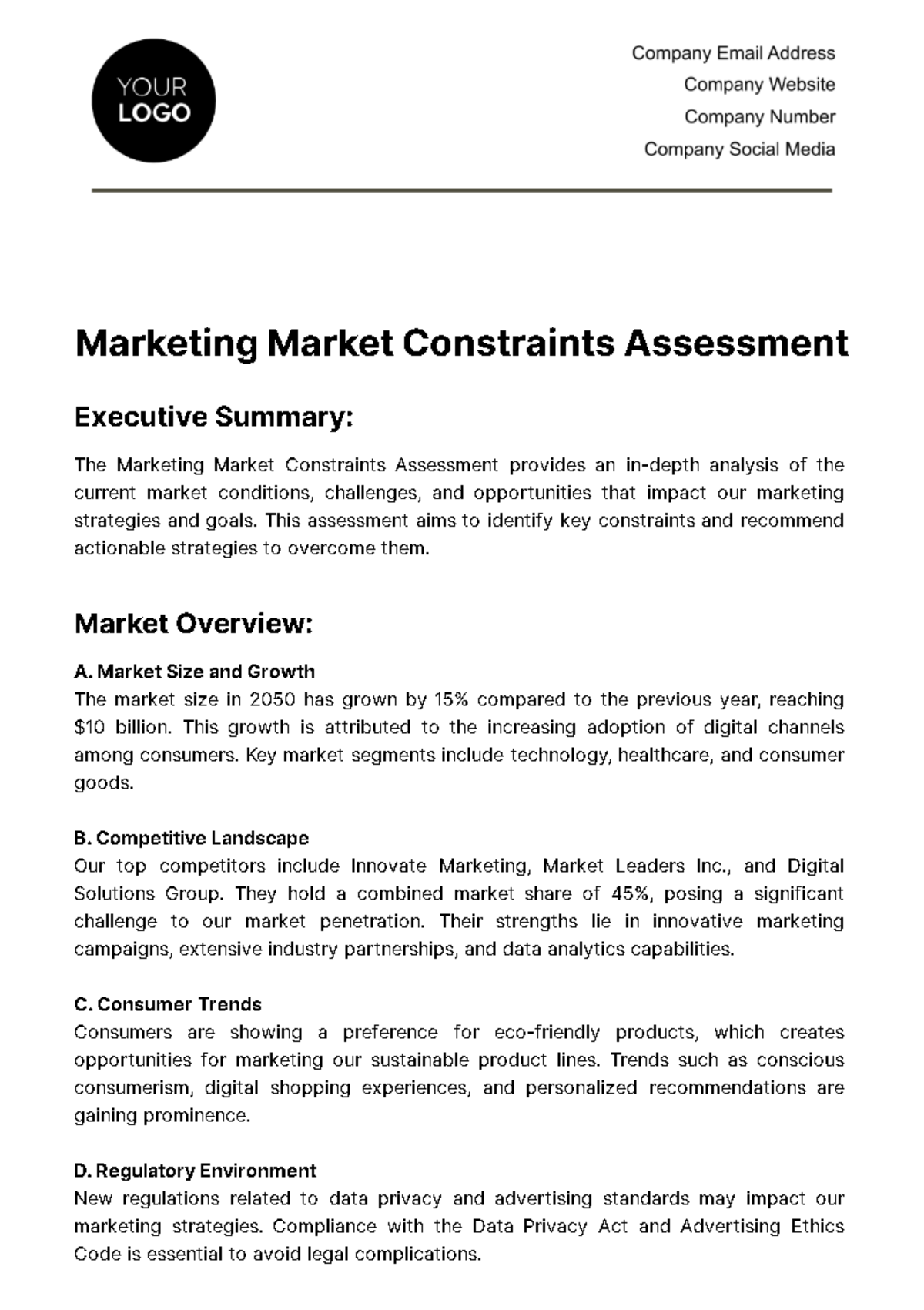Marketing Market Constraints Assessment
Executive Summary:
The Marketing Market Constraints Assessment provides an in-depth analysis of the current market conditions, challenges, and opportunities that impact our marketing strategies and goals. This assessment aims to identify key constraints and recommend actionable strategies to overcome them.
Market Overview:
A. Market Size and Growth
The market size in 2050 has grown by 15% compared to the previous year, reaching $10 billion. This growth is attributed to the increasing adoption of digital channels among consumers. Key market segments include technology, healthcare, and consumer goods.
B. Competitive Landscape
Our top competitors include Innovate Marketing, Market Leaders Inc., and Digital Solutions Group. They hold a combined market share of 45%, posing a significant challenge to our market penetration. Their strengths lie in innovative marketing campaigns, extensive industry partnerships, and data analytics capabilities.
C. Consumer Trends
Consumers are showing a preference for eco-friendly products, which creates opportunities for marketing our sustainable product lines. Trends such as conscious consumerism, digital shopping experiences, and personalized recommendations are gaining prominence.
D. Regulatory Environment
New regulations related to data privacy and advertising standards may impact our marketing strategies. Compliance with the Data Privacy Act and Advertising Ethics Code is essential to avoid legal complications.
Internal Constraints:
Constraints | Description |
Budget Limitations | Our marketing budget for 2050 faces a 10% reduction due to company-wide cost-cutting measures. This budget constraint affects our ability to launch aggressive marketing campaigns and explore new channels. |
Resource Allocation | The efficient allocation of resources for marketing campaigns remains a challenge. We need to streamline our processes to ensure that resources are directed towards high-impact initiatives, such as the launch of our new product line. |
Talent and Skills Gap | We lack experts in emerging marketing technologies, which hampers our ability to stay competitive. Hiring or upskilling our team in areas like AI-driven marketing, data analytics, and social media trends is essential for staying ahead of the curve. |
Technology Infrastructure | Our current marketing technology stack needs an upgrade to support data-driven decision-making and automation. Investing in marketing automation tools and customer relationship management (CRM) systems is crucial to enhance efficiency. |
External Constraints:
Constraints | Description |
Economic Factors | Economic uncertainty in the wake of global events affects consumer spending and demands a flexible marketing approach. We should monitor economic indicators closely and adjust our marketing strategies accordingly, especially in markets with high volatility. |
Socio-cultural Factors | Changing demographics and cultural shifts require adjustments in our messaging and targeting. Conducting regular market research to understand evolving consumer values and preferences is crucial for tailoring our campaigns effectively. |
Technological Trends | The rapid pace of technological advancements necessitates staying updated to remain competitive. Exploring emerging technologies such as augmented reality (AR) and virtual reality (VR) for marketing campaigns can provide a competitive edge and enhance consumer engagement. |
Legal and Regulatory Factors | Compliance with evolving data privacy laws and advertising regulations is vital to avoid legal issues. We need a dedicated legal team to monitor and ensure compliance with data protection regulations and industry-specific advertising standards. |
Customer Analysis:
A. Target Audience Segmentation
Our target audience includes millennials and Gen Z, with distinct preferences and behaviors. Segmentation based on factors like age, income, and lifestyle is necessary to tailor our messaging effectively. We should also consider segmenting by ethical and sustainability preferences.
B. Customer Feedback and Surveys
Regular feedback indicates a need for improved customer service and product customization. Conducting surveys and actively seeking customer opinions can guide our marketing strategies and help us deliver exceptional customer experiences.
C. Changing Customer Preferences
Customers are increasingly valuing convenience and personalized experiences in their interactions with brands. We should invest in personalization technologies and streamline customer journeys, including personalized recommendations and post-purchase support.
D. Competitive Customer Offerings
Monitoring competitor offerings helps us identify gaps we can exploit to attract more customers. Conducting regular competitor analysis and benchmarking is crucial for differentiating our products and services in the market.
Recommendations:
A. Strategic Marketing Plan
Develop a data-driven marketing strategy that aligns with emerging consumer trends and leverages our strengths. Focus on launching innovative, sustainable product campaigns and partnerships with eco-conscious influencers.
B. Resource Reallocation
Optimize resource allocation to ensure maximum ROI for marketing campaigns. Consider reallocating resources from traditional advertising to digital channels and influencer collaborations.
C. Technology Enhancement
Invest in marketing technology upgrades to enhance data analytics and automation capabilities. Implement advanced marketing automation tools to personalize customer interactions and optimize ad spending.
D. Regulatory Compliance Strategy
Establish a robust compliance framework to navigate evolving regulations effectively. Assign a compliance officer to oversee adherence to data privacy laws and industry-specific advertising standards.
E. Customer-Centric Approach
Prioritize customer feedback and tailor marketing efforts to meet evolving customer preferences. Launch a customer feedback program, and implement personalized marketing campaigns based on data insights, ensuring a seamless customer journey.
Conclusion:
This Marketing Market Constraints Assessment provides a comprehensive analysis of the challenges and opportunities in the market landscape of 2050 for [Your Company Name]. By addressing these constraints and implementing the recommended strategies, we can position ourselves for sustainable growth and competitive advantage in a dynamic market environment.
Marketing Templates @ Template.net






























